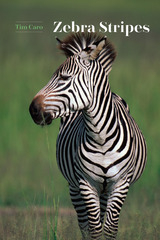3 start with Z start with Z

Popular explanations for stripes range from camouflage to confusion of predators, social facilitation, and even temperature regulation. It is a serious challenge to test these proposals on large animals living in the wild, but using a combination of careful observations, simple field experiments, comparative information, and logic, Caro is able to weigh up the pros and cons of each idea. Eventually—driven by experiments showing that biting flies avoid landing on striped surfaces, observations that striping is most intense where biting flies are abundant, and knowledge of zebras’ susceptibility to biting flies and vulnerability to the diseases that flies carry—Caro concludes that black-and-white stripes are an adaptation to thwart biting fly attack. Not just a tale of one scientist’s quest to solve a classic mystery of biology, Zebra Stripes is also a testament to the tremendous value of longitudinal research in behavioral ecology, demonstrating how observation, experiment, and comparative research can together reshape our understanding of the natural world.


The Zoology of Tapeworms was first published in 1952. Minnesota Archive Editions uses digital technology to make long-unavailable books once again accessible, and are published unaltered from the original University of Minnesota Press editions.
Leaders in helminthology have long recognized the need for such a work as this—a comprehensive study of tapeworms. This definitive treatise describes the tapeworms of the world—their gross and microscopic anatomy, their physiology, life cycles, and relationships to hosts, the theories of origin and evolution, and the various systems of classification that have been applied to tapeworms.
Detailed, systematic descriptions and keys for the identification of all known genera of the world and species of North America are provided. Emphasis on the theoretical significance of various aspects of tapeworm zoology is balanced by a wealth of detailed description. A bibliography up to 1950 is appended.
A review of the literature on each topic is incorporated in the discussions. Starting with a few fragments of information a century or more ago, the literature on the subject of tapeworms has appeared in a wide range of journals and books published in at least five languages. Many of the older publications are, for practical purposes, unavailable, and a number of the more recent journals are difficult to obtain. Therefore, the consolidation of this large body of scattered literature in a single volume will be of value to scientists in many fields.
In addition to filling a basic need for helminthologists, this book should serve as a reference work for parasitologists, zoologists, ecologists, clinicians, medical research workers, and students and workers in various fields of biology.
There are 419 text illustrations from drawings of species by the authors.
READERS
Browse our collection.
PUBLISHERS
See BiblioVault's publisher services.
STUDENT SERVICES
Files for college accessibility offices.
UChicago Accessibility Resources
home | accessibility | search | about | contact us
BiblioVault ® 2001 - 2024
The University of Chicago Press









